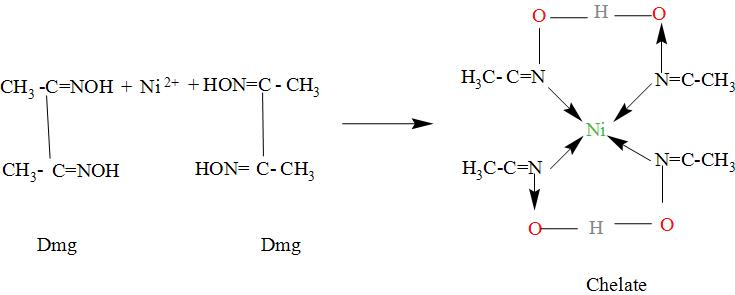
Which of the following represents a chelating ligand?
(a) ${{H}_ {2}} O$
(b) $C{{l}^ {-}} $
(c) $OH^{-}$
(d) DMG
Answer
474.9k+ views
Hint: First find out the ligand which has two or more than donor atoms and then you can easily get to know about the chelating ligand.
Complete step by step answer:
Chelating ligands are those ligands (those molecules which are attached to the central metal atom through the coordinate bonds) which binds the central metal atom through two or more donor atoms of the ligands and results in the formation of cyclic ring compounds known as chelates and the process is known as chelation.
Chelating ligands are actually multidentate ligands which upon coordination with the central metal atom results in the formation of cyclic (ring) compounds. All the types of bidentate, tridentate, tetradentate, pentadentate and hexadentate ligands are known to form a variety of chelates.
Chelates or the chelated complexes have been found to be much more stable than the similar complexes with unidentate ligand (uni means one and dentate refers to the denticity which means the number the donor groups which can donate electron to the central metal atom and forms the coordinate bond with it). It is so because the chelate, as we know, is a cyclic ring and involves the breaking of the two bonds unlike the one in non- chelated complexes.
Now, in the above, we can see that in $H_2O$ that there is only one donor atom and thus is monodentate ligand (mono means one i.e. one donor atom).
In $Cl^{-}$ there is also one donor atom i.e. the chlorine itself and thus it is also a monodentate ligand.
In $OH^{-}$ there is also one donor atom i.e. the oxygen itself and thus it is also a monodentate ligand.
In DMG i.e. Dimethylglyoxime, it is a bidentate ligand in which both the nitrogen atoms of a dmg molecule donates electrons to the central metal atom and forms the coordinate bonds. And thus, is a chelating ligand and forms the chelates. DMG is mostly used for the estimation of nickel as follows:

So, hence option (d) is correct.
Note: Monodentate ligands never form chelates because they involve one donor atom only. Always remember that polydentate ligands i.e. bidentate, tridentate etc. always act as chelating ligands and thus, forms the chelates.
Complete step by step answer:
Chelating ligands are those ligands (those molecules which are attached to the central metal atom through the coordinate bonds) which binds the central metal atom through two or more donor atoms of the ligands and results in the formation of cyclic ring compounds known as chelates and the process is known as chelation.
Chelating ligands are actually multidentate ligands which upon coordination with the central metal atom results in the formation of cyclic (ring) compounds. All the types of bidentate, tridentate, tetradentate, pentadentate and hexadentate ligands are known to form a variety of chelates.
Chelates or the chelated complexes have been found to be much more stable than the similar complexes with unidentate ligand (uni means one and dentate refers to the denticity which means the number the donor groups which can donate electron to the central metal atom and forms the coordinate bond with it). It is so because the chelate, as we know, is a cyclic ring and involves the breaking of the two bonds unlike the one in non- chelated complexes.
Now, in the above, we can see that in $H_2O$ that there is only one donor atom and thus is monodentate ligand (mono means one i.e. one donor atom).
In $Cl^{-}$ there is also one donor atom i.e. the chlorine itself and thus it is also a monodentate ligand.
In $OH^{-}$ there is also one donor atom i.e. the oxygen itself and thus it is also a monodentate ligand.
In DMG i.e. Dimethylglyoxime, it is a bidentate ligand in which both the nitrogen atoms of a dmg molecule donates electrons to the central metal atom and forms the coordinate bonds. And thus, is a chelating ligand and forms the chelates. DMG is mostly used for the estimation of nickel as follows:

So, hence option (d) is correct.
Note: Monodentate ligands never form chelates because they involve one donor atom only. Always remember that polydentate ligands i.e. bidentate, tridentate etc. always act as chelating ligands and thus, forms the chelates.
Recently Updated Pages
Glucose when reduced with HI and red Phosphorus gives class 11 chemistry CBSE

The highest possible oxidation states of Uranium and class 11 chemistry CBSE

Find the value of x if the mode of the following data class 11 maths CBSE

Which of the following can be used in the Friedel Crafts class 11 chemistry CBSE

A sphere of mass 40 kg is attracted by a second sphere class 11 physics CBSE

Statement I Reactivity of aluminium decreases when class 11 chemistry CBSE

Trending doubts
10 examples of friction in our daily life

The correct order of melting point of 14th group elements class 11 chemistry CBSE

Difference Between Prokaryotic Cells and Eukaryotic Cells

One Metric ton is equal to kg A 10000 B 1000 C 100 class 11 physics CBSE

What is the specific heat capacity of ice water and class 11 physics CBSE

State and prove Bernoullis theorem class 11 physics CBSE




